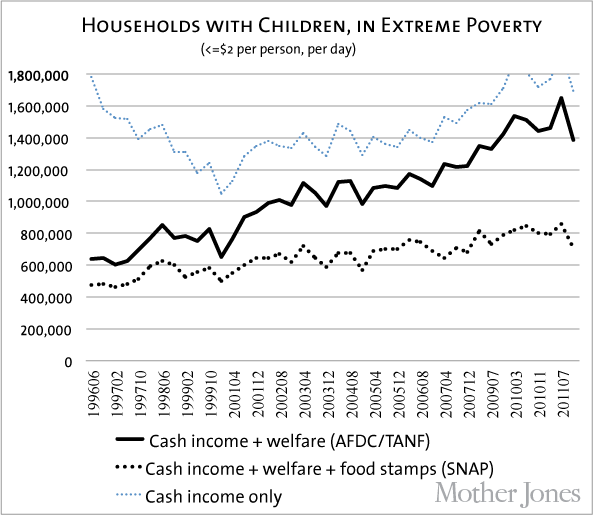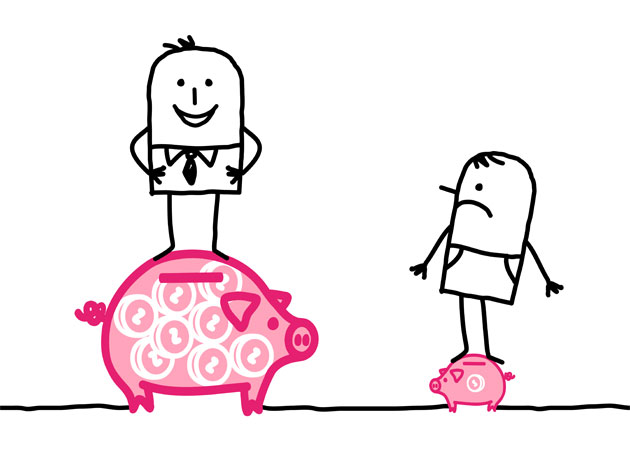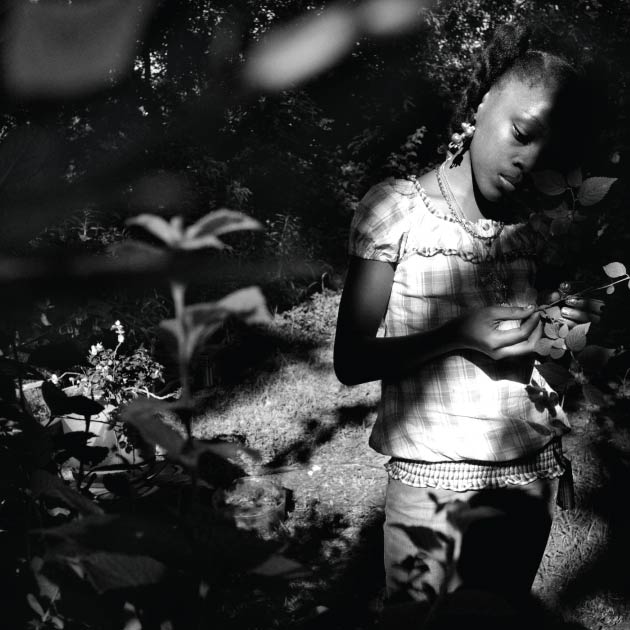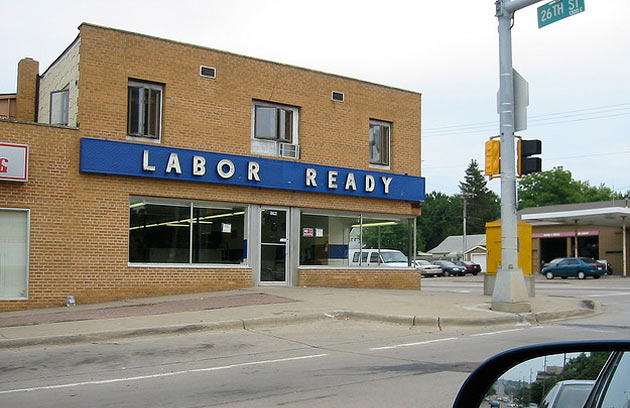
<a href="http://www.flickr.com/photos/wwarby">wwarby</a>/Flickr
This story was produced with support from the Economic Hardship Reporting Project.
Two years ago, Harvard professor Kathryn Edin was in Baltimore interviewing public housing residents about how they got by. As a sociologist who had spent a quarter century studying poverty, she was no stranger to the trappings of life on the edge: families doubling or tripling up in apartments, relying on handouts from friends and relatives, selling blood plasma for cash. But as her fieldwork progressed, Edin began to notice a disturbing pattern. “Nobody was working and nobody was getting welfare,” she says. Her research subjects were always pretty strapped, but “this was different. These people had nothing coming in.”
Edin shared her observations with H. Luke Shaefer, a colleague from the University of Michigan. While the income numbers weren’t literally nothing, they were pretty darn close. Families were subsisting on just a few thousand bucks a year. “We pretty much assumed that incomes this low are really, really rare,” Shaefer told me. “It hadn’t occurred to us to even look.”
Curious, they began pulling together detailed household Census data for the past 15 years. There was reason for pessimism. Welfare reform had placed strict time limits on general assistance and America’s ongoing economic woes were demonstrating just how far the jobless could fall in the absence of a strong safety net. The researchers were already aware of a rise in “deep poverty,” a term used to describe households living at less than half of the federal poverty threshold, or $11,000 a year for a family of four. Since 2000, the number of people in that category has grown to more than 20 million—a whopping 60 percent increase. And the rate has grown from 4.5 percent of the population to 6.6 percent in 2011, the highest in recent memory save 2010, which was just a tad worse (6.7 percent).
But Edin and Shaefer wanted to see just how deep that poverty went. In doing so, they relied on a World Bank marker used to study the poor in developing nations: This designation, which they dubbed “extreme” poverty, makes deep poverty look like a cakewalk. It means scraping by on less than $2 per person per day, or $2,920 per year for a family of four.
In a report (PDF) published earlier this year by the University of Michigan’s National Poverty Center, Edin and Shaefer estimated that nearly 1 in 5 low-income American households were living in extreme povery; since 1996, the number of households in that category had increased by about 130 percent (118 percent if you use the latest numbers available). Among the truly destitute were 2.8 million children. Even if you counted food stamps as cash, half of those kids were still being raised in homes whose weekly take wasn’t enough to cover a trip to Applebee’s.

In the researchers’ eyes, it was a bombshell. But the media barely noticed. “Nobody’s talking about it,” Edin gripes. Even during a presidential campaign focusing on the economy, only a few local and regional news outlets took note of their report on the plight of America’s poorest families. Mitt Romney told CNN that he wasn’t concerned about the “very poor,” who, after all, could rely on the nation’s “very ample safety net.” Even President Obama was reticent to champion any constituent worse off than the middle class. As journalist Paul Tough noted in the New York Times Magazine this past August, the politician who cut his teeth as an organizer in inner-city Chicago hasn’t made a single speech devoted to poverty as president of the United States. (Paul Ryan has.)
IF YOU WANT to explore the dire new landscape of American poverty, there’s perhaps no better place to visit than Fresno, a sprawling, smoggy city in California’s fertile Central Valley. Heading south on Highway 99, I pass acres of grapevines and newly constructed subdivisions before reaching the city limit, where a sign welcomes me to California’s Frontier City. Ahead, no doubt, is a city, but all I see is brown haze. It’s as if a giant dirt clod had been dropped from space. The frontier looks bleak.
In 2005, after Hurricane Katrina briefly focused the nation’s attention on the plight of the poor, the Brookings Institution published a study looking at concentrated poverty. Only one city fared worse than New Orleans: You guessed it, Fresno. Earlier this year, the US Census identified Fresno County as the nation’s second-poorest large metropolitan area. Its population has nearly doubled over the past three decades, which means more competition for minimum-wage farm and service-sector jobs, and a quarter of the county’s residents fall below the federal poverty threshold. With fewer than 20 percent of adults 25 and up holding bachelors degrees, there’s little prospect of better-paying industries flocking here.
For those living on the margins here, daily life can be a long string of emergencies. “There’s this whole roiling of folks,” says Edie Jessup, a longtime local anti-poverty activist. “They are homeless, move in someplace else, lose their jobs and are evicted, maybe end up in motels.”
If I want to see how bad things are, Jessup advises, I should check out the area southwest of downtown. She gives me directions, and after crossing some train tracks near a pristine minor-league baseball stadium, I find myself in a virtual shantytown. Amid boarded up warehouses and vacant lots, the streets begin to narrow. They are filled with structures made of pallets, plywood, and upended shopping carts. A truck pulls up filled with bottles of water, and a long line of thirsty people forms.
Amid the makeshift shelters, one section of pavement has been cleaned up, fenced off, and filled with more than 60 Tuff Sheds—prefab tool sheds brought in to provide emergency housing for Fresno’s growing street population. “It’s not ideal,” concedes Kathryn Weakland of the Poverello House, the nonprofit that oversees the encampment and doles out 1,200 hot meals a day. “But like one of the homeless told me, it beats sleeping in a cardboard box.”
The collection of sheds even has a name: “Village of Hope.”
IN THE WEE HOURS of the following morning, I pay a visit to Josefa, a 37-year-old single mother from Mexico who lives in a low-slung apartment complex just north of downtown. She’s awake and ready by 3 a.m. when the first family knocks on her door. A Latino couple hands off two children and a sleeping baby and then disappears into the dark, heading for fields outside of town. Over the next half hour, two more farmworker families do the same. The small living room is soon filled with kids in various states of somnolence. Some nestle together on couches; others spread out on blankets on the floor. Josefa heads down the hallway to her bedroom, cradling the baby girl and walking quietly to avoid waking her 10-year-old daughter in the next room.
Four hours later, she has accomplished the morning’s major chores: Five of the six kids are awake, fed, and dressed. The only holdout is a feisty toddler who is waging a mighty fuss over the prospect of wearing a T-shirt. Josefa gives the edges of the boy’s shirt a sharp downward tug and smiles, winning a small but important battle. After pulling her curly black hair into a ponytail she looks at her watch. “Let’s go!” she calls, waving her hands toward the door. “We’re going to be late.”
The group heads down a dirt alleyway, led by a tiny girl wearing a pink Dora the Explorer backpack that looks big enough to double as a pup tent. The school is three blocks away. Along the way, we pass modest but tidy single-family homes, a few shoddy apartment complexes, and two boarded-up buildings. On the surface, there’s little to distinguish this neighborhood—known as Lowell—from other hardscrabble sections of Fresno. But Lowell is, in fact, the poorest tract in the city and among the poorest stretches of real estate in America. More than half of its residents, including nearly two-thirds of its children, live in poverty. One in four families earns less than $10,000 a year.
In a county where unemployment now hovers around 14 percent, Josefa is lucky to have work. Even better, she loves her job, and 10 minutes in her company is enough to realize she’s got a gift with children. “They run up on the street and hug me,” she says, beaming. “What could be better?”
What she lacks is money. Her farmworker clients are barely scraping by, so she only charges them $10 a day per child. At the moment it’s late September, the heart of the grape season, so she’s got a full house. But at times when there’s less demand for farm work, or the weather is wet, she gets by largely on her monthly $200 allotment of food stamps. “I don’t even have enough to pay for a childcare license,” Josefa says. (Because of this, I’ve agreed to change her name for this story.)
Josefa estimates that her childcare business brings in $7,000 a year. She visits local churches for donated food and clothes, and has taken in relatives to help cover her $600 rent. Until earlier this year, Josefa and her daughter shared their small apartment with her niece’s family. It was hardly ideal—some days, there were 12 people sardined in there. “Of course I need more money,” Josefa tells me, pushing a stroller and holding the toddler’s hand as we arrive back at her place. “But how can I charge more when no one has any more to give?”
Her niece, Guillermina Ramirez, is sitting in the apartment complex’s small courtyard and overhears Josefa’s last comment. “The key is to learn English,” she announces. Guillermina, like Josefa, is undocumented, but she’s married to a US citizen and says she will be a legal resident soon. She recently enrolled in English classes and anticipates securing “a really good job” once she’s done. “That’s what you need to get ahead.”
Gary Villa and Jim Harper speak English and both are American citizens—as a member of the Northern Cheyenne Nation, Harper’s lineage goes way back—but neither would say he’s getting ahead. I run into the two men outside a temp agency three miles from Josefa’s apartment. They’ve been waiting around since well before sunrise in hopes of finding something.
Villa, a stocky 23-year-old with a shaved head and goatee, tells me that he was pulling in a decent paycheck installing phone boxes for an AT&T subcontractor before he got laid off in 2008. He was evicted from his apartment and now lives with his mother—”It’s kind of embarrassing,” he mutters—while his girlfriend and two kids moved in with a relative. “You can’t pay $800 in rent making $8 an hour.”
Villa peers inside the job office, trying to discern any movement.
“At least we have family to fall back on,” says Harper, 33, who keeps his long brown hair tucked beneath a red-and-blue Fresno State cap. After being let go from his job delivering radiators, he tried starting a handyman business called Jim’s Everything Service. It didn’t work out, so now he begins each day by calling seven temp agencies. But Fresno was slammed hard by the housing bust, and it remains a tough place for unemployed blue-collar workers. Harper, who is staying with his stepfather, says he’s lucky to pull in more than $200 a month. His monthly food stamp allotment tacks on another $200, for an annual income of $4,800.
By now the sun is well above the horizon and it’s shaping up to be yet another day without a paycheck. “The working class isn’t the working class if there’s no work, right?” says Harper, who is wearing paint-stained Dickies and a faded T-shirt. “We’re getting pretty desperate out here.”
“I like to joke that I’ll take any job short of being a male whore,” he adds.
True enough, when the temp office clerk announces that there’s a job available, Harper leaps at it even though the gig starts at 2 a.m. and he knows he’ll have to arrive at the work site in the early evening, thanks to Fresno’s limited bus service. He shrugs off the six hours he’ll waste “twiddling his thumbs.” What matters, Harper says, is to keep knocking on doors and making the calls, because “you never know when you might get your foot in the door.”
Fleeing Fresno’s hostile job market might seem like the logical solution, but it’s never that simple. As frequently happens with the very poor—especially in light of the restrictions put in place with welfare reform—the informal safety nets that help keep people afloat also tend to keep them rooted in place. Losing his delivery job left Harper homeless. For a few months he lived out of his car or in a room in Fresno’s “motel row,” notorious for drugs and prostitution. But since moving into his stepfather’s house, he’s been able to use food stamps in lieu of rent. Leaving town would mean running the risk of being homeless again. And given Harper’s income, there’s no room for error.
Neither is there a clear path out of deep poverty for Josefa. She puts in 12-hour days six days a week, so there’s not much room to increase her workload. By allowing six other families to work, she plays a small but key role in making Fresno an agriculture powerhouse, but her cut is minuscule. “That’s why it’s so important for my daughter to study,” she says.
The last time I speak to Harper, he tells me he’s landed a stint working overnight at a series of grocery stores that are overhauling their freezer compartments. “It looks like it will be a 10-day job,” he says, excited. In Fresno, that counts as a big success. I ask where he hopes to find himself in five years. He pauses and takes a deep breath. “Best-case scenario, as sad as it sounds, is to be no worse off than I am right now,” he says. “That’s about all I can hope for.”
This story was produced with support from the Economic Hardship Reporting Project.















